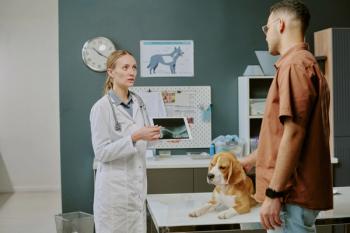
Update on treating canine staphylococcal skin infections (Sponsored by Pfizer Animal Health)
Recent developments in Staphylococcal skin infections are changing the diagnostic process and treatment.
Patients with staphylococcal skin infections are seen every day in small-animal general practice. However, recent developments in treatment options, along with concerns about emerging antibiotic resistance, are changing the way we diagnose and treat these conditions. These six key points highlight the current principles and practices:
1. Treating a staphylococcal infection is not enough. It is critical to search for the underlying cause of the infection and treat or prevent it.
Coagulase-positive staphylo-cocci are normal organisms on canine and feline skin. Infection occurs only in the presence of an underlying cause. It's important to explain to clients that the staphylococcal infection is not something that their pet contracted from the environment or another animal. Some physiologic or micro-environmental change had to occur in the skin to allow colonization and infection. Thus, particularly in the case of recurrent infections, it is critical to search for this underlying cause and treat or prevent it.
2. The choice of systemic antibiotic treatment is based on considerations of efficacy, safety, cost, and client compliance.
Based on all these factors, veterinary dermatologists generally consider cephalo-sporins the antibiotics of choice for staphylococcal skin infections (Table 1). These drugs combine high efficacy and safety with reasonable cost and relatively infrequent development of resistance.
Other classes of antibiotics (e.g., macrolides, lincosamides, potentiated sulfa drugs) are generally associated with resistance rates of 10% to 30%, and resistance can develop rather rapidly with repeated use. Fluoroquinolone antibiotics, though effective against many staphylococcal infections, should be reserved for more unusual situations, such as Pseudomonas infections or organisms resistant to other drugs. Interestingly, chloramphenicol is making a comeback as an antibiotic useful for highly resistant strains of Staphylococcus. Because this antibiotic is, in my opinion, one of our last remaining hopes for some infections, it should never be used unless it is clear that no alternative exists, as documented by culture and susceptibility testing.
3. Staphylococcal skin infections should be treated for at least one to two weeks past clinical resolution of the lesions.
Some practitioners advocate prolonged, continuous, or pulse treatment schedules for patients with recurrent infections, but their advisability has been questioned recently. Generally, visible lesions of staphylococcal infection disappear before the infection is fully cured. Superficial infections are usually treated for three to six weeks, depending on severity and patient response. Deeper infections (e.g., furuncles, deeper abscesses, draining tracts) usually require much longer treatment—six to 12 weeks is common. Because of these rather long treatment durations, clients may become weary of administering oral medications, particularly those that must be administered several times daily (usually in addition to multiple other recommended treatments such as shampoos and topicals).
Using once-daily products, such as cefpodoxime, may enhance compliance with the treatment regimen and unburden the pet owner. Recently available is a long-acting injectable cephalosporin, cefovecin. Each single subcutaneous injection of this aqueous product is equivalent to a two-week course of an orally administered cephalosporin in the treatment of superficial staphylococcal pyoderma.
4. Increasingly, staphylococcal skin infections may require a culture and sensitivity test prior to treatment.
The rule of thumb for when to culture includes resistance, response, and recurrence. A few years ago, culture and susceptibility tests were rarely necessary before treating staphylococcal skin infections—their susceptibility patterns were predictable, as nearly 100% of isolates were susceptible to a cephalosporin.
This situation has now changed. Emergence of resistant strains dictates that any animal with apparent resistance to treatment or inadequate response to treatment must be cultured. Likewise, a recurrent infection should always be cultured, especially if the animal has been treated frequently in the past with various antibiotics. The goal is not only to choose the correct antibiotic, but also to identify the presence of methicillin-resistant strains. If the laboratory reports a coagulase-positive Staphylococcus that is methicillin-resistant, order a staphylococcal speciation test.
This test identifies the particular strain of Staphylococcus present and if it is a human or animal strain. This information will allow you to take necessary isolation precautions and to advise the client about any zoonotic concern.
5. Adjunct treatment with topical antimicrobials or immunomodulatory products is becoming more important, particularly for recurrent infections.
To every veterinarian's frustration, the underlying reason for recurrent infections sometimes defies diagnosis— the infections respond completely to antibiotic treatment yet continue to recur soon after such treatment is discontinued. Topical therapy (e.g., antimicrobial shampoos, conditioners, or sprays) is especially recommended in cases of recurrent infection to more quickly eradicate the organism from the hair coat and potentially prevent recolonization.
Injectable staphylococcal bacterins will also prevent recurrence in some cases.
6. Educate yourself and your clients about procedures for—and potential hazards of—methicillin-resistant staphylococcal infections.
News stories on the emergence of superbugs appear in the popular press with increasing frequency, sometimes with an alarming tone. We now know that most staphylococcal infections on animals occur with the coagulase-positive species Staphylococcus intermedius (now known as Staphylococcus pseudintermedius and Staphylococcus schleiferi These species prefer to colonize animals and are not transmitted to people under usual circumstances. On the other hand, Staphylococcus aureus prefers to colonize people. Only about 1% of canine staphylococcal skin infections can be attributed to S. aureus and only about one third of those are methicillin-resistant. Any staphylococcal species can become methicillin-resistant. Methicillin, a laboratory reagent, has been used to test staphylococci for antibiotic resistance. A strain of methicillin-resistant Staphylococcus (MRS) will be completely resistant to treatment with all penicillin and cephalosporin drugs. In some cases, MRS will be susceptible to other routine antibiotics, such as potentiated sulfas or fluoroquinolones; in other cases, MRS can be highly resistant to nearly all antibiotics, except perhaps chloramphenicol and other esoteric and very expensive human drugs.
What's the implication?
The landscape of staphylococcal infections is changing. New drugs make client compliance more practical. Studies are underway to determine how often patients, owners, and veterinarians are carriers of resistant strains and to determine the significance of such carriage. It seems clear that future cases will increasingly call for judicious use of antibiotics and the use of non-antibiotic alternatives when possible. We must redouble our efforts to use these important drugs wisely.
Table 1: Antibiotics for treatment of staphylococcal pyoderma
Poor choices
Poor choices due to frequent resistance of coagulase-positive Staphylococcus strains:
- Ampicillin
- Amoxicillin
- Penicillin
- Other non-penicillinase resistant penicillins
- Tetracyclines
- Non-potentiated sulfa drugs.
Adequate choices
Adequate initial choices for staphylococcal pyoderma, but 10% to 30% of staphylococcal strains will be resistant. These are also poor choices for prolonged or repeated use because of the likelihood of drug resistance development over time. The potentiated sulfa drugs have been more often associated with idiosyncratic adverse drug reactions, so some clinicians avoid them.
Drug.........................................................Dosage
Clindamycin.................................................5.5 to 11 mg/kg po b.i.d.
Erythromycin................................................10 to 15 mg/kg po t.i.d.
Lincomycin...................................................22 mg/kg po b.i.d.
Trimethoprim-sulfa combinations.................15 to 30 mg/kg po b.i.d.
Good choices
Antibiotics that are good initial choices for pyoderma and that are generally good choices for prolonged or repeated use, because of apparent difficulty with which drug resistance develops over time. Note that some dermatologists recommend a higher-than-labeled dose for amoxicillin-clavulanic acid (given below) in treating skin infections. Client compliance is likely to be better with injectable cefovecin or once-daily cefpodoxime.
Drug...............................................................Dosage
Amoxicillin-clavulanic acid...............................15 to20 mg/kg po b.i.d. to t.i.d.
Cefovecin.........................................................8 mg/kg subcutaneously, repeated in 14 days if indicated
Cefpodoxime....................................................5 to1 0 mg/kg po s.i.d.
Cephalexin.......................................................22 to30 mg/kg po b.i.d.
Additional choices
Antibiotics that are often effective for staphylococcal infections but that should not be used for routine cases. Reserve these antibiotics for unusual situations such as methicillin-resistant staphylococci (chloramphenicol) or nonstaphylococcal infections—such as Pseudomonas (fluoroquinolones). Note the flexible dosage range for the fluoroquinolones; the correct dose to use is ideally based on the minimal inhibitory concentration (MIC) of the organism, but in general is the highest for Pseudomonas and mid-range for staphylococci.
Drug................................................................Dosage
Chloramphenicol............................................ 40 to 50 mg/kg po t.i.d.
Enrofloxacin................................................... 5 to 20 mg/kg po s.i.d.
Marbofloxacin................................................ 2.75 to 5.5 mg/kg po s.i.d.
Orbifloxacin................................................... 2.5 to 7.5 mg/kg po s.i.d.
Newsletter
From exam room tips to practice management insights, get trusted veterinary news delivered straight to your inbox—subscribe to dvm360.




